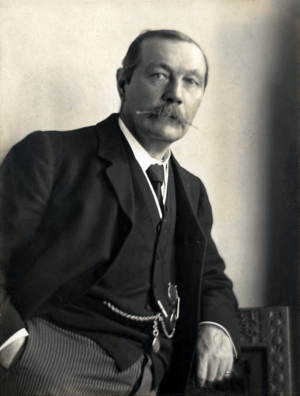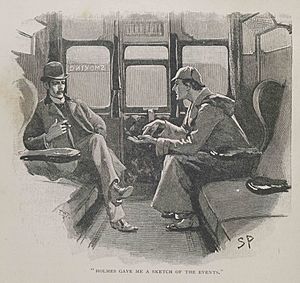Dr. Watson facts for kids
Quick facts for kids Dr. Watson |
|
|---|---|
| Sherlock Holmes character | |

Dr. Watson (left) and Sherlock Holmes, by Sidney Paget.
|
|
| First appearance | A Study in Scarlet (1887) |
| Last appearance | "The Adventure of Shoscombe Old Place" (1927, canon) |
| Created by | Arthur Conan Doyle |
| Information | |
| Occupation | Physician, writer, consulting detective, Royal Army surgeon, war veteran |
| Title | Doctor |
| Family | H. Watson Sr. (father; deceased) |
| Spouse(s) | Mary Morstan (late 1880s – between 1891 and 1894) Second unnamed wife (c. 1903–??) |
| Nationality | British |
| Alma mater | St Bartholomew's Hospital Medical College |
John H. Watson, usually called Dr. Watson, is a made-up character from the famous Sherlock Holmes detective stories. These stories were written by Sir Arthur Conan Doyle. Dr. Watson first appeared alongside Sherlock Holmes in the book A Study in Scarlet in 1887. The last story where Doyle wrote about Watson and Holmes was "The Adventure of Shoscombe Old Place" (1927).
Watson is Sherlock Holmes's best friend, helper, and flatmate. He tells most of the stories from his point of view. Watson is shown as a typical gentleman from the Victorian era. He is smart and clever, but not quite as brilliant at solving mysteries as Holmes.
Because he is Holmes's friend and trusted helper, Dr. Watson has appeared in many movies, TV shows, video games, comics, and radio programs.
Contents
Creating Dr. Watson

When Sir Arthur Conan Doyle first planned the stories, Holmes's friend had a different name. Doyle eventually decided on "John Watson." He might have been inspired by one of Doyle's real-life friends, Dr. James Watson.
Dr. Watson is very important to the stories. He helps Holmes think through his ideas. From a writer's point of view, it was important to have someone for the detective to talk to. Watson knows the facts of a case but doesn't always understand Holmes's conclusions until Holmes explains them. Any character who does this in a mystery story is often called a "Watson."
What is Dr. Watson Like?
How Dr. Watson Looks
In A Study in Scarlet, Watson is described as very thin and tanned after returning from Afghanistan. Later stories say he is strongly built, about average height, with a thick neck and a small moustache.
Watson used to be an athlete. In "The Adventure of the Sussex Vampire", it's mentioned he played rugby union for Blackheath. In "His Last Bow", which takes place in 1914, Watson is described as "a heavily built, elderly man with a grey moustache."
Dr. Watson's Skills and Personality
Watson is intelligent, but he doesn't have the same amazing insight as Holmes. He is a good contrast to Holmes: a typical gentleman from the late Victorian era or Edwardian period compared to Holmes, who is brilliant but doesn't show much emotion. Holmes also thinks Watson is an excellent doctor and surgeon.
Watson knows his own limits and how much Holmes depends on him. He once said that he was like a "whetstone" for Holmes's mind, helping Holmes's ideas become clearer.
Sometimes, Watson tries to solve crimes using Holmes's methods. For example, in The Hound of the Baskervilles, Watson figures out some mysteries on his own. Holmes even praises him for his effort and intelligence. However, Watson doesn't have Holmes's incredible ability to focus on tiny details or his wide range of special knowledge. This means Watson often has limited success when trying to solve cases alone.
Holmes once told Watson in "A Scandal in Bohemia": "You see, but you do not observe." This means Watson sees things, but he doesn't always notice the important details. Even so, Watson can be quite clever. He has a strong sense of honor and is very good at keeping secrets.
Dr. Watson's Influence
Because Dr. Watson tells the Sherlock Holmes stories, he has inspired many similar characters. After Watson appeared, having a "Watsonian narrator"—a character close to the detective but who doesn't fully understand the investigation—became a common part of classic detective stories. This type of character is often called "the Watson."
The partnership between Holmes and Watson has influenced many detective teams in British fiction. This includes Hercule Poirot and Captain Hastings (created by Agatha Christie) and Inspector Morse and Sergeant Lewis (created by Colin Dexter). Watson also influenced other fictional helpers, like Bunny Manders (who helps the gentleman thief A. J. Raffles) and Archie Goodwin (who assists detective Nero Wolfe).
Even Microsoft named a debugger program in Microsoft Windows "Dr. Watson" because it helps find problems.
Images for kids
See also
 In Spanish: Doctor Watson para niños
In Spanish: Doctor Watson para niños




